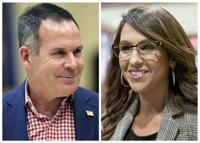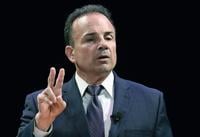DENVER (AP) ÔÇö Colorado's election recount rules could help determine the extent of RepublicansÔÇÖ slim majority in the lower chamber of Congress by deciding the outcome of Republican Rep. Lauren BoebertÔÇÖs reelection race against Democrat Adam Frisch.
The thin margin in the sprawling 3rd Congressional District, which covers the state's largely rural western and southern territory, could trigger a rare automatic recount. The Associated Press declared the race too close to call Thursday night with Boebert up by 551 votes out of nearly 327,000 cast and nearly all votes counted. The AP won't make a call until after the recount, if there is one.
Until election night, Boebert was considered practically unbeatable in the conservative district after her anti-establishment rhetoric built a loyal base and brought national attention alongside fellow hard-liners such as Georgia Rep. Marjorie Taylor Greene.
Frisch, a former councilman in who campaigned on a largely conservative platform while minimizing his Democratic Party affiliation, tried to entice disaffected Republicans by attacking what he called Boebert's ÔÇťanticsÔÇŁ and ÔÇťangertainment."
Frisch , acknowledging that it is highly unlikely enough votes will flip to give him a victory even though he supports the recount. Boebert Thursday night.
For both parties, the stakes are high. So how will it work? Q: WHEN IS A RECOUNT TRIGGERED IN COLORADO?
A: In Colorado, an automatic recount is triggered when the margin of votes between the top two candidates is at or below 0.5% of the leading candidateÔÇÖs vote total. Candidates can also request a recount, paid for by their campaign, if the votes fall outside of that margin.
BoebertÔÇÖs lead as of Thursday night translated to about 0.34%.
Q: WHAT WOULD BE THE TIMELINE FOR A RECOUNT?
A: Colorado Secretary of State Jena Griswold has until the end of the day Dec. 5 to declare whether the vote margin is tight enough to require a mandatory recount. Counties must complete the retabulation by Dec. 13.
Q: HOW DOES A RECOUNT ITSELF WORK?
A: Griswold's office will send out the rules and relevant dates to the counties. County clerks then run what's called a logic and accuracy test on their voting equipment. The test feeds imitation ballots through the system to ensure that the machines' counts match a hand count. If a machine fails the assessment, ballots will be hand counted.
If the machines pass the tests, the ballots are then rescanned. If the machine can't determine a voter's choice, bipartisan teams review those ballots to determine who gets those votes.
The whole process is overseen by a canvass board staffed by both Democratic and Republican representatives.
Q: HOW COMMON ARE RECOUNTS IN U.S. ELECTIONS?
While historical data on U.S. House race recounts isn't readily available, statewide election recounts are extremely rare. Nationwide, there have been 31 recounts in statewide races since 2000.
Q: HOW OFTEN DO RECOUNTS REVERSE THE RESULTS?
Just three of those recounts changed the outcome of the election, and the largest initial margin between the candidates in those races ÔÇö 261 votes ÔÇö was considerably smaller than Boebert's lead.
The largest swing in terms of number of votes was in the 2018 Florida Senate race. In the initial count there, Rick Scott led Ben Nelson by 12,562 votes. After a machine recount and a manual recount, Scott eventually won by 10,033 votes, for a shift of 2,529 votes, or 0.03%, out of 8.2 million votes cast.
In Colorado, the last statewide recount was triggered automatically over two decades ago in a race for State Board of Education. The retabulation upheld the initial results.
___
Jesse Bedayn is a corps member for the Associated Press/Report for America Statehouse News Initiative. Report for America is a nonprofit national service program that places journalists in local newsrooms to report on undercovered issues.
___
Check out to learn more about the issues and factors at play in the 2022 midterm elections.
Follow APÔÇÖs coverage of the elections at:








































